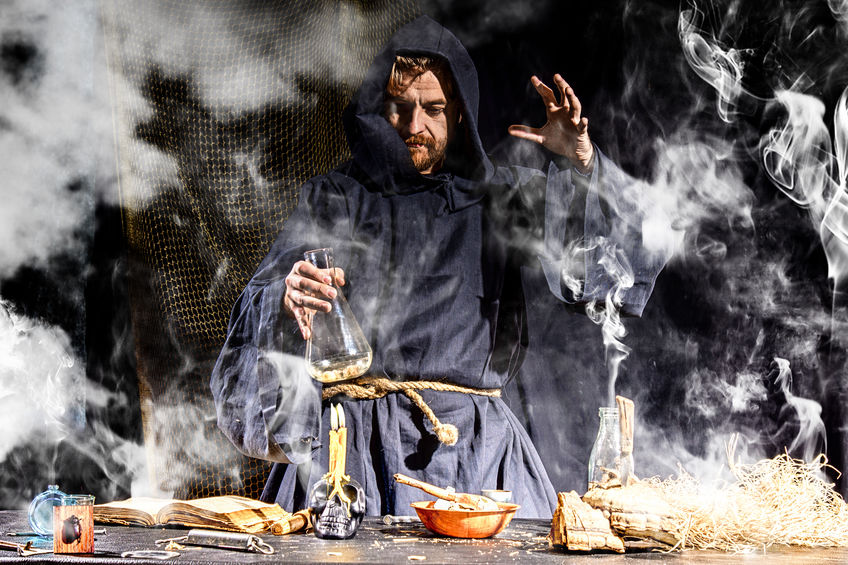 Submitted by Alchemyst on
Submitted by Alchemyst on

Image by Sergey Ishkov from http://123rf.com
Throughout much of the 20th century, the academic community had little patience with alchemists and their vain efforts to transmute base metals into gold. Any contemporary scholar who even dared to write about alchemy, historian Herbert Butterfield warned, would “become tinctured with the kind of lunacy they set out to describe.”
But, in the 1980s, some revisionist scholars began arguing that alchemists actually made significant contributions to the development of science. Historians of science began deciphering alchemical texts—which wasn’t easy. The alchemists, obsessed with secrecy, deliberately described their experiments in metaphorical terms laden with obscure references to mythology and history. For instance, text that describes a “cold dragon” who “creeps in and out of the caves” was code for saltpeter (potassium nitrate)—a crystalline substance found on cave walls that tastes cool on the tongue.
This painstaking process of decoding allowed researchers, for the first time, to attempt ambitious alchemical experiments. Lawrence Principe, a chemist and science historian at Johns Hopkins University, cobbled together obscure texts and scraps of 17th-century laboratory notebooks to reconstruct a recipe to grow a “Philosophers’ Tree” from a seed of gold. Supposedly this tree was a precursor to the more celebrated and elusive Philosopher’s Stone, which would be able to transmute metals into gold. The use of gold to make more gold would have seemed entirely logical to alchemists, Principe explains, like using germs of wheat to grow an entire field of wheat.
Principe mixed specially prepared mercury and gold into a buttery lump at the bottom of a flask. Then he buried the sealed flask in a heated sand bath in his laboratory.
One morning, Principe came into the lab to discover to his “utter disbelief” that the flask was filled with “a glittering and fully formed tree” of gold. The mixture of metals had grown upward into a structure resembling coral or the branching canopy of a tree minus the leaves.
What intrigues Principe and his fellow historians, though, is the growing evidence that the alchemists seem to have performed legitimate experiments, manipulated and analyzed the material world in interesting ways and reported genuine results. And many of the great names in the canon of modern science took note, says William Newman, a historian at Indiana University Bloomington.
Robert Boyle, one of the 17th-century founders of modern chemistry, “basically pillaged” the work of the German physician and alchemist Daniel Sennert, says Newman. When Boyle’s French counterpart, Antoine-Laurent Lavoisier, substituted a modern list
of elements (oxygen, hydrogen, carbon and others) for the ancient four elements (earth, air, fire and water), he built on an idea that was “actually widespread in earlier alchemical sources,” Newman writes. The concept that matter was composed of several distinctive elements, in turn, inspired Sir Isaac Newton’s work on optics—notably, his demonstration that the multiple colors produced by a prism could be reconstituted into white light.
Other scholars have at times responded to this idea with outrage. Principe was once confronted at an academic conference by a member of the audience who was “literally shaking with rage that I could defame Boyle in this way.” But younger academics have taken up alchemy as a hot topic. The early revisionist research, says Principe, “cracked open the seal and said ‘Hey, look everybody, this is not what you thought it was.’”
In a mark of that new acceptance, the Museum Kunstpalast in Düsseldorf, Germany, will present a show, beginning in April, that—along with alchemy-influenced artworks, from Jan Brueghel the Elder to Anselm Kiefer—will include an exhibit on Principe’s “Philosophers’ Tree” experiment.
Does this new view of alchemy make the great names in the early history of science seem more derivative and thus less great? “We were just talking in my class about the rhetoric of novelty,” says Principe, “and how it benefits people to say that their discoveries are completely new.” But that’s not how scientific ideas develop. “They don’t just sort of come to someone in a dream, out of nowhere. New scientific ideas tend to develop out of older ones by a slow process of evolution and refinement.”
From that perspective, the scientific revolution may have been a little less revolutionary than we imagine. Better to think of it as a transmutation, like the alchemists’ quest to change lead into gold.
Richard Conniff
________________________________________________________________________________________________________________________________________
Why the alchemist's attempted to conceal their chemical knowledge and how?
One-- the alchemists thought they had or were on the verge of getting really powerful knowledge. That is, how to make gold out of base metals. So this is a dangerous kind of knowledge. If it falls into the wrong hands, then an unscrupulous person could destroy the economy of states by undermining the value of gold. Also, it was personally dangerous. If you claimed openly that you have the knowledge or you're on the verge of getting the knowledge of how to make gold, you're likely to find yourself arrested and put into prison, being put to work by whoever the local king or prince is. There are lots of examples of alchemists that this happened to. Moreover, alchemy was, in fact, illegal in many European countries from the Middle Ages down to the early modern period. This is because rulers were afraid of undermining the gold standard, of corrupting the gold supply in Europe.
So alchemists adapted the way they wrote to be more secretive. They tended to write under false names. They attributed their writings to people who were safely dead. And they tended to write in code. They would rarely list the clear name of some substance that they were using. So let me give you an example.
If an alchemist were using what he would call "sal ammoniac" or what we would nowadays call ammonium chloride, we know that it's a white, volatile salt. Instead of calling it sal ammoniac, for example, he might call it the white eagle, because an eagle flies just the way the salt volatilizes. Similarly, if you were talking about, let's say, nitric acid, rather than calling it spirit of saltpeter or something that would be more easy to understand, he might instead call it red dragon. Well, why? Well, because if you heat up nitric acid, you get these red vapors, so there's the red part. It essentially breathes fire, this corrosive material. There's corrosive vapors that would come out of it on heating. And it's ravenous. It devours everything in its path, just the way a dragon would do.
So for example, if we wanted to make aqua regia, a solvent that's able to dissolve gold, today we could take nitric acid and put ammonium chloride in it and make that solvent. But an alchemist might describe it by saying, let the red dragon devour the white eagle or rather than saying it in words, he could draw an image of an actual dragon devouring an eagle. So these extravagant Baroque images that clutter alchemical texts from the 16th and 17th centuries often have a hidden chemical meaning. It was a coded way of communicating, both concealing from people who were unworthy of the knowledge, but revealing it to the people who were in the know or were worthy of being in the know.
Larry Principe, Professor of the History of Science and Technology and a Professor of Chemistry at Johns Hopkins University.
Read more @ https://www.britannica.com/video/187015/alchemists-knowledge
Posted for educational/informational purposes only.
- 482 reads
